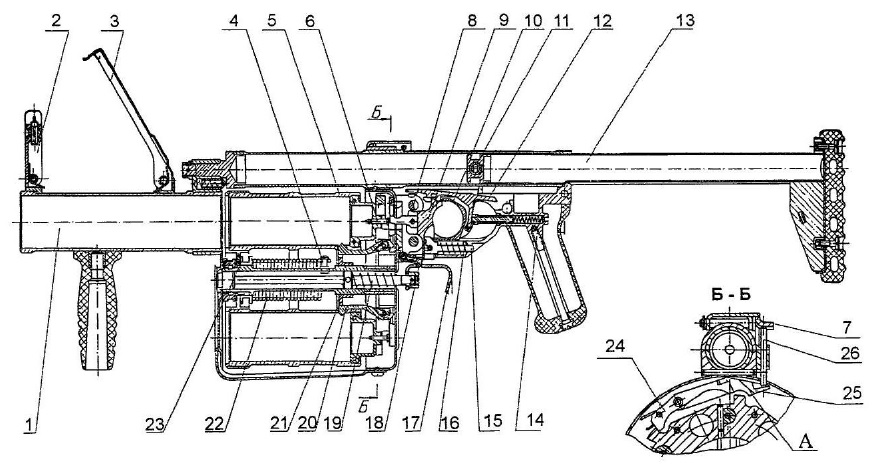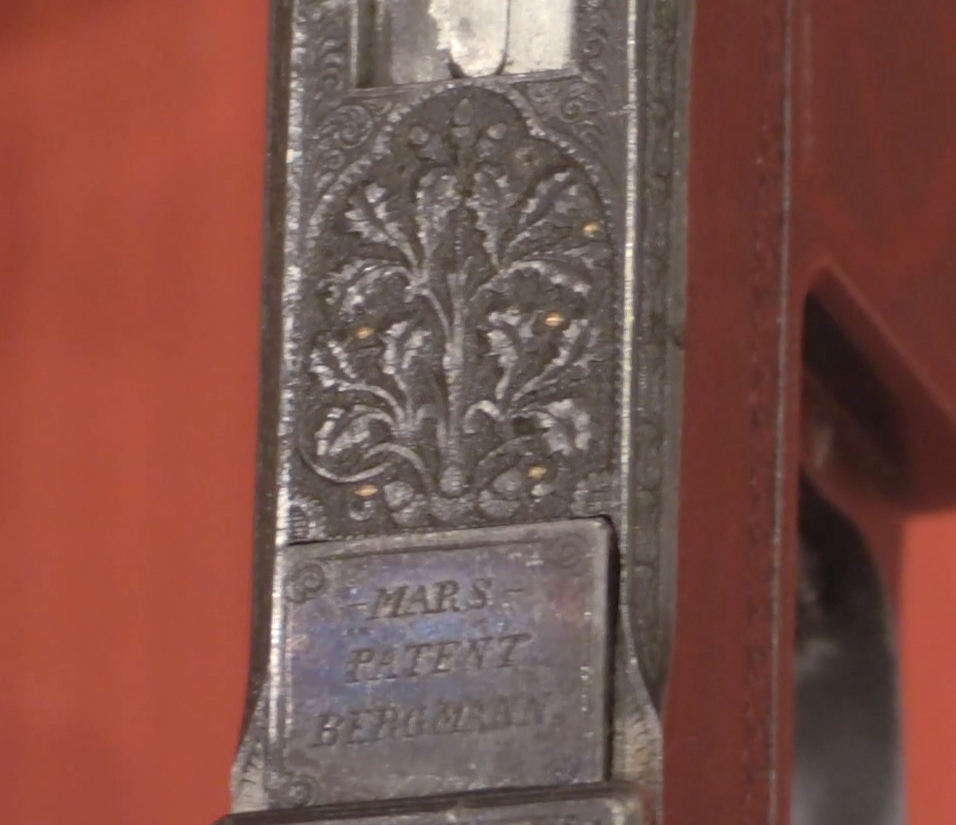When the German Army announced in 1934 that it would be adopting a new standard rifle, the JP Sauer company jumped at the chance to submit a model for consideration. Auger has a complete production line for the Mauser pattern rifles, having produced Gewehr 98s during World War One, and it had access to Mauser’s “Gewehr für Deutsches Reichspost” rifles that were clearly the basis for what the Army wanted. So Sauer didn’t just submit a model for Army consideration, they actually put it into full production without waiting for the Army’ decision (Mauser did the same).
As it turned out, the Sauer rifle differed from the final K98k standard only in its barrel band retention system. After this pattern was announced in June 1935, the company transitioned its production to meet those details. The rifles already made were still taken into military service, though.
This example is marked S/147/K, indicating Sauer production in 1934. It I the highest known serial number of this year, and a beautiful example. It is all matching, and still has very good finish and very nice stock markings. A really interesting piece of the story of German 1930s rearmament!




And people get on the French for adopting the MAS-36 when they did, one year after the Germans adopted the K98k. Both were obsolescent when adopted.
K98k was simple development of already existed weapon and generally following development of adjacent countries like Puška vz. 24 or Karabinek wz.29, as opposed to brand new design like MAS-36.
I would submit that neither the Germans nor the French saw it that way; both of them intended to adopt something more modern when it was available. The French came closest, with the MAS44 rifle, but it didn’t happen due to their defeat in ’41. The MAS36 was supposed to be the “arm the rear echelon” weapon, but it turned into the basic rifle for the French because they had to do something about the totally obsolescent 8mm Lebel rifles they were saddled with. Arguably, they could have done better, but there were a lot of reasons they didn’t, not the least of which were the political ones. If the French had given their military the money they needed when they needed it, the MAS44 might have been the MAS37, and been on hand in sufficient quantities to arm troops. As it was, they barely got the MAS36 into service as a stopgap…
I don’t think it’s quite correct to say that the French military screwed up with the MAS36; they did the best they could, within the limitations of the politics and budget they had to deal with.
The Germans were in the same boat; they had to recapitalize their basic infantry individual weapon, and they were doing budget triage as they did so. The intent was to have a modern semi-auto on issue by the time they were supposed to be fighting WWII, in the mid-1940s, but we all know how that worked out. They instead chose to prioritize on what they thought a better solution for squad firepower, which was the MG34/42 family of GPMGs. That’s where they spent their money, after spending the least they could on a modernized Mauser 98. In their case, I think that they made the right choice, which is pretty much validated by the vast differential in inflicted casualties by German infantry against Allied infantry formations, whenever the fight came down to organic weapons. Didn’t work so well when inundated by tanks and fighter-bombers, but they managed to dominate things well into the war.
One does wonder what WWII would have looked like, had they fought it when it was planned for–The mid-1940s. Germany might not have even started the war, likely being bankrupted by their rearmament programs and social spending, had they waited on things. On the other hand, a bunch of Allied developmental stuff would have been online by then, so…? Who knows?
I think it would have worked out in entirely unknowable and unexpected ways, however… Hell, it might have gone nuclear from the beginning, with the Germans totally unprepared to cope with that aspect of it all. Like WWI, WWII went the way it did primarily due to the technology of the era being what it was. Change the dates, change the technology, change the course of the war. It’d be interesting to work out the counterfactuals, somehow, but we’re never going to know.
For the French one should not forget, that the French army was changing over to the new rimless 7,5 × 54 mm cartridge and rebuilding the old model 1886 Lebel rifles for it made no sense at all, really. Tube fed and basically a Gras rifle converted to nitro powder. The Berthier rifles were also a bit long in the tooth and also built around the 8mm Lebel rimmed cartridge. Then it ws clear that France was not going to be able to manufacture the planned self-loading rifles in numbers to arm all of the forces. So making a new simple bolt-action made perfect sense.
In the German case the Reichswehr was still mostly using old long rifles with various shorter carbines of various types sprinkled in, so standardizing on a new universal short rifle pattern made sense too, as the changes were not that big really. shorter barrel, new rear sights. That was about it as Ian says in the video and lots of new rifles were being needed for rearmament. So that made sense too, as Germany was as you say concentrating on the machine gun and there would probably not enough self-loaders going to be manufactured very probably as well. Well and then the convoluted and red-taped process of how Germany’s armies got self-loaders in the end is one longwinded tale in itself. So bolt-action for the masses was a safe bet. The Soviets had in their progressive forward dreaming planned to give everyone self-loaders jsut like the americans, but ended up making more Mosin-Nagant rifles than before WW2 had ever been made. The British stayed away from self-loaders and like the Germans put their bet on bolt-action rifles and section machine guns. It played out pretty much the same for every participant in WW2 really. With the exception of the USA, who had enough manufacturing capability to arm everyone with a M1 Garand self-loading rifle.
Actually, there were Berthier rifles converted to 7.5 x 54mm. about 63,000 altogether;
https://www.forgottenweapons.com/m34-the-berthier-converted-to-the-7-5mm-rimless-cartridge/
Considering that the process involved not only a new barrel but changing the Mannlicher-type single-row en bloc clip magazine out for a Mauser-type double-stack five-round internal one, it would be more exact to call this a total rebuild as opposed to “just” a conversion.
In fact, the result was probably a better design overall than the MAS36.
cheers
eon
Interesting that AJP Taylor says that the French fired the opening shot of the arms race.And then the British joined in.Since the British and French refused to abide by the Versailles Treaty, Hitler said that neither would Germany.
The Versailles treaty is solely about Germany, the Trianon Treaty solely about Austria. There are no regulations regarding UK or France in either document.
Truly.
May I please inquire, which particular French act he considers “firing the opening shot” and starting the arms race? If anything I think about the interwar French as being behind the times on their modernization efforts.
The R.F.V. (Reichs-Finanzverwaltung) was the administrative part of the Finanzministerium, somewhat like the U.S. Internal Revenue Service is part of the Department of Treasury.
In Germany, the Customs (Zoll, or Douane in some other European countries) was part of RFV. It is therefore highly probable that the rifle survived the war in a Customs office (Zollamt).
After WW2, the Zoll at first again carried rifles, the Zollkarabiner with a 52 cm barrel.
Deutsches Reichspost? An interesting organization.
Not only in the “neither rain nor snow” caper, they had a private army, but their real “party” trick was to run a nuclear research programme of impressive scale. A different “Men In Black” show?
DRP was sort of what we’d have had if we’d crossed Bell Telephone, RCA, IBM, and what became the Atomic Energy Commission with the U.S. Postal Service and all of the then major radio networks (NBC, ABC, CBS, and DuMont), plus Western Union.
Among other things, the DRP ran both the German telephone and telegraph systems and their then-infant television system. (Yes, Germany actually had broadcast TV to theaters in the late 1930s.)
The director of the DRP was Dr. Wilhelm Ohnesorge, a physicist by trade and a frenetic Nazi “true believer”. Ironically, in German, “ohne sorge” means “without worries”. Which doesn’t really describe the nature of his job, I’m sure.
cheers
eon
// Auger // has a complete production line for the Mauser pattern rifles, ….
Auger? Is this the correct name?
I think someone’s autocorrect butchered Sauer into a plumbing concern ….
A priest, a minister, and a rabbit walk into a bar. Bartender says to the rabbit, “What are YOU doing here?” Rabbit says, meekly, “Autocorrect?”